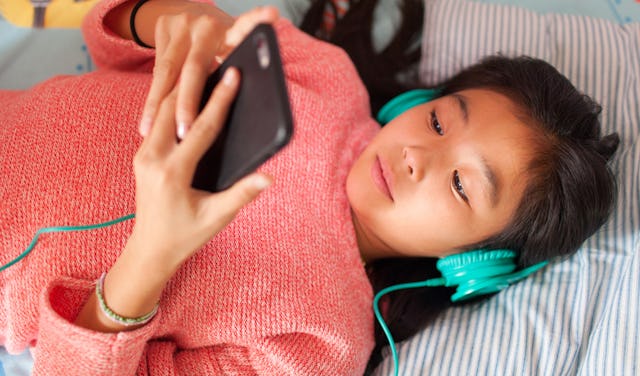Should You Be Screening Your Kid’s Playlist?
Here's what an expert says — plus, what that Parental Advisory warning really means.

You're in the car, listening to your tween in the backseat scream-sing Chappell Roan's "Pink Pony Club" or vibe along to Tommy Richman's "Million Dollar Baby" when a thought occurs to you: Should you be vetting what your kid listens to more? In the era of TikTok and Spotify, kids are exposed to tons of music — and, sure, a lot of the songs skew more mature. But it's what everyone their age seems to be listening to, so what's the harm, right?
Screening your kid's playlists feels like a helicopter parenting move, but even content from pop artists like Taylor Swift might be worth a closer listen. Still, an expert says it's less about age and more about their ability to interpret mature themes. "Kids mature at different ages, and what one child might be able to process and compartmentalize might be different from peers of the same age range," says Jillian Amodio, licensed master social worker and founder of Moms For Mental Health.
It's a nuanced discussion, for sure, but here are a few things to consider when it comes to screening your child's playlists.
When and What To Screen
The problem doesn't necessarily lie within the lyrics of your kid's favorite songs but with how your kid might interpret the lyrics and how those lyrics might influence their beliefs and actions. In fact, Amodio says that allowing your child to listen to age-inappropriate lyrics, including those that introduce false narratives, can have adverse effects.
"Potential negative consequences or impacts of allowing children to listen to music with mature themes or content can include copying the behaviors and language, not understanding the nature or meaning of what they've heard, and possibly misusing or repeating what they've heard in inappropriate or undesirable situations, and possibly being made to feel uncomfortable by concepts they aren't quite mature enough to know how to process," says Amodio.
The last thing any parent wants is for their kid to think that getting back at an ex is the right way to handle a breakup or that self-harm or violence solves problems. And because values and core beliefs are instilled primarily in the home, Amodio says it's essential for parents to foster open and honest communication about the media their kids are accessing. Not only can this approach open up the lines of communication, but it also instills a sense of trust and respect.
Open Communication Is Key
"Monitoring and screening media should be a collaborative effort. It should be done with knowledge from the child so that they feel like they are part of the process. They don't always have to agree, but they should be involved," says Amodio. "Sometimes, as parents, we have to make decisions for our children that they don't agree with, but if we can involve them in the decision-making process, it can increase trust and respect and help them to understand that it is not that the parent does not trust the child, it is that is it is the parent's job to ensure safety.
While the Parental Advisory label (aka the "PAL Mark") on an album is designed to warn parents of potentially inappropriate content, it is usually used when strong language, depictions of violence, sex, or substance abuse are present — which means that other inappropriate or misleading themes can and are often included within the lyrics, including content that Amodio explains can be considered disrespectful or harmful to specific populations.
Behavioural Red Flags
Because kids often break the rules or give in to peer pressure, restricting them from mature content won't always be possible. However, keeping an eye on their behaviors can help clue parents in on potential behavioral, mental, or social issues. These behaviors can include the use of mature language, age-inappropriate sexual expression, offensive language towards others or groups of people, violent reactions or outbursts, and depression or acts of self-harm.
Amodio believes that, even at that point, communication can be tremendously helpful — whether it's parent-child communication or with intervention from a mental health expert — noting the importance of helping kids understand the difference between what they hear and real life.
"While music and media can be a safe and creative way to explore social constructs and societal concepts, the artistic representation and exploration displayed in the media do not always translate seamlessly to real life, so parents should be ready to have conversations about reality versus artistic expression," says Amodio. "As parents, even if a topic is shocking, it is important that we approach the conversation with an open mind and a calm demeanor, and encourage our children to continue to come to us with concerns. If a child has been exposed to content that they are not emotionally ready to handle or mature enough to process, it is important to ensure they have a safe space to unpack what they have seen or heard."
You Know Your Kid (and Your Boundaries)
So, the two big takeaways are to keep the lines of communication open and to watch for any behavioral warning signs or understanding gaps. But it's also a matter of personal boundaries. If you let your kid curse at home, you may be totally unfazed by the lyrics other parents flag. You know what you're comfortable with, and you likely also have a pretty good grasp on your kid's maturity level. Consider Amodio's advice and just keep an eye, er, ear out.